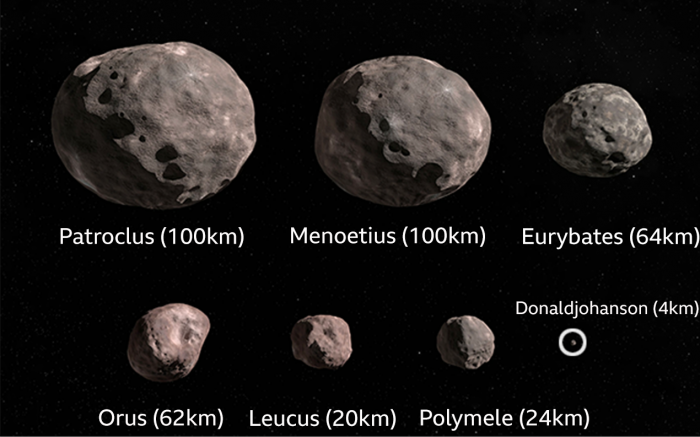NASA recently launched a space mission that took direct inspiration from a famous human origins story — a fossil from Africa, nicknamed Lucy, taught us much about where our species came from.
The Lucy space probe, however, seeks the fossils of our Solar System that are hundreds of millions of kilometres from Earth.
Beyond the main asteroid belt, alongside the gigantic planet Jupiter, hundreds and thousands of unexplored worlds, each smaller than 250 kilometres across, holds precious secrets of our Solar System’s birth.
And studying these asteroids — collectively known as the Jupiter Trojans — is what Lucy plans to do during its 12-year, 6.5-billion kilometre voyage.
An interesting flight route.
One of the most fascinating aspects of this mission is the journey the probe takes to reach its targets.
Powered by two massive seven-metre solar arrays, the Lucy space probe follows a complex trajectory that places it in a six-year orbit around the sun. After a series of Earth flybys that harnesses our planet’s gravity for extra travel juice, in 2025 Lucy will fly past the Donaldjohanson asteroid — a 4-kilometre-wide object named after the paleoanthropologist who discovered the Lucy fossil.

Lucy’s flyby targets and their estimated size. Photo credits: NASA
After its first encounter, Lucy will then embark on the journey to pass through the leading Trojan swarm in 2027, flying by five Trojans (Eurybates. Queta, Polymele, Leucus and Orus) all at once. The next flyby will be in 2033, where Lucy will dip into the trailing Trojan swarm, dashing past Patroclus and Menoetius, a binary asteroid system.
This intricate cosmic choreography was brilliantly created by Brian Sutter, Lockheed Martin’s mission design lead for the Lucy space probe. Check out this video and this GIF showing the trajectory of the mission from different angles.
As long as the spacecraft remains healthy after completing its planned mission, NASA can continue doing loops through the swarms and even propose extended missions to explore more trojans. Many NASA missions have historically run past their intended timeline to perform even more science, such as the Mars Curiosity Rover, which has been roving the Red Planet for almost a decade.
Time capsules from the birth of our Solar System.
During the flybys, Lucy will come within almost 1000 kilometres of its target asteroids at dizzying velocities of nearly 25,000 kilometres per hour. Instruments aboard Lucy are therefore extremely precise. For instance, its high-resolution visible imager, L’LORRI, affectionately called the “eagle eyes” of the mission, is so sensitive that it can clearly see craters with a diameter of 70 metres from 1000 kilometres away!
Data captured using the space probe, detailing the asteroids’ colour, composition, mass, density and surface geology, should then help scientists decipher when and where each formed within the Solar System.
Researchers will also be able to construct and improve simulations of the early Solar System, revealing how our neighbourhood around the sun came to be and may even tell us about the kinds of organic materials that may have been supplied to the early Earth.
From asteroid sampling to asteroid hunting and asteroid blasting, NASA sure has many asteroid-related tricks up their sleeves!
Just as the Lucy fossil provided unique insights into humanity’s evolution, NASA’s Lucy mission promises to revolutionise our understanding of planetary origins and unlock the mysteries surrounding the formation of our Solar System.






























